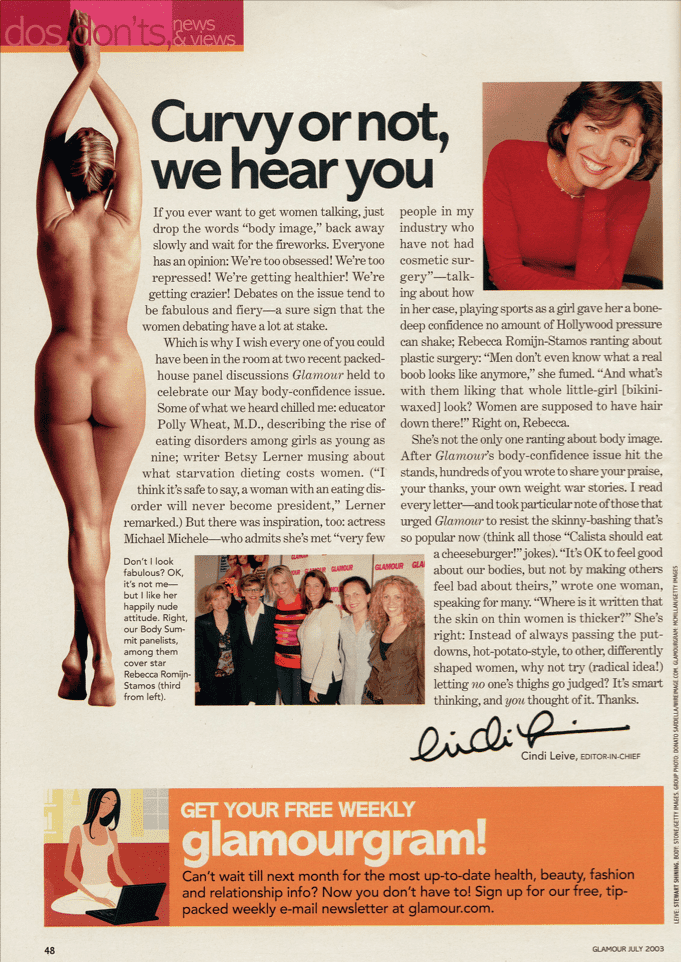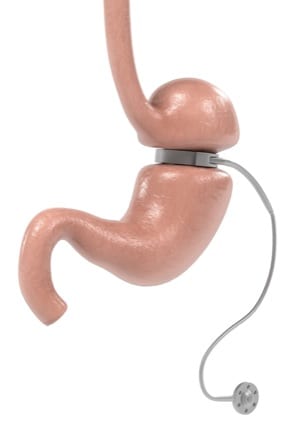Articles

OB/GYN Edition
August 2003
VOL. 28, No. 8
Treatment of Obesity in the Female Patient:
The Role of Laparoscopic Adjustable Gastric Banding
By Camelia A. Davtyan, MD; David G. Davtyan, MD
Obesity is becoming a global health problem; with 8.2% of the world population classified as obese. The World Health Organization estimates that the number of obese adults increased by 50% to 300 million between 1985 and 2000. In 1999, 27% of US adults were obese (body mass index [BMI] greater than 30 kg/m2), and 61% were overweight (BMI greater than 25 kg/m2). This represents a major upsurge from only two decades ago, when the prevalence of obesity in the United States was 15% and 46% of adults were overweight. It is estimated that approximately 300,000 deaths per year are due to obesity, and because the prevalence of obesity is growing, mortality from the condition may soon exceed smoking-related mortality. The average American gains about 20 lb between the age of 25 and 55 years, which can result from consuming as little as 6 kcal/d over the individual’s metabolic rate. There are more men than women with a BMI of 25 to 29.9, but women match or exceed men when it comes to BMI greater than 30. Black women have an incidence of obesity 80% higher than their male counterparts, and Mexican American women also have a higher incidence of obesity than Mexican American men. Most obese women gain their excess weight after puberty, often associated with pregnancy, hormonal contraceptives, and/or menopause.
There is a growing concern regarding comorbidities affecting more than 14 million obese Americans. Hypertension, type 2 diabetes, dyslipidemia, coronary artery disease, sleep apnea, asthma, gastroesophageal reflux, degenerative joint disease, parenchymal liver disease, gallbladder disease, certain malignancies (breast, colon, prostate, kidney, esophagus, endometrium), infertility, and premature death are all more common among the obese population. It was estimated in 1996 that the cost of obesity-related morbidity had mounted to 6.8% of the total US health care expenditure.
Most long-term studies of obesity treatment show a high prevalence of weight regain; indeed, more than 33% of patients who had lost weight, regained one third of it within 1 year and almost 100% of it within 5 years. In 2000, the National Institutes of Health (NIH) developed evidence-based guidelines for obesity treatment based on almost 400 randomized controlled trials of obesity therapy. These guidelines endorse diet, physical activity, and behavioral therapy for all patients with a BMI of 25 to 29.9 with comorbidities. If diet and exercise fail, the NIH also endorsed pharmacotherapy for people with a BMI exceeding 30 with out comorbidities. Surgery is recommended for patients with a BMI greater than 40 (or greater than 35 with comorbidities) when less invasive methods have failed and the patient is at risk for obesity-associated morbidities and mortality.
NONSURGICAL TREATMENT
Life-style changes are the first line of therapy for over-weight and obese individuals. Low-calorie diets can reduce body weight by 8% over 6 months, and regular exercise (three to seven sessions of 30 to 60 minutes each per week) can produce weight loss of 2% to 3% independent of diet. Ongoing behavioral therapy can increase compliance with life-style changes, and can support weight reduction. A combined approach of low-calorie diet, regular exercise, and behavioral therapy is recommended by the NIH guidelines.
Pharmacotherapy is a second-line approach when life-style changes alone do not achieve weight loss. It can produce 6% to 10% weight loss at 1 year, with a significant risk of regain after the medication is stopped. It should not be initiated unless the patient has demonstrated significant life-style changes involving diet, exercise, and behavioral modification. The long-term risks and benefits of these medications are unknown. Historically, amphetamines, phenylpropanolamine, phentermine and fenfluramine, orlistat, and sibutramine have been used to promote weight-loss. Fenfluramine was withdrawn from the market following reports of adverse effects on the heart and pulmonary arteries.
SURGICAL TREATMENT
Bariatric Surgery is a third-line resort when life-style changes and medications are not successful. Most surgeons and health plan adhere to the 1991 NIH Consensus guidelines, which endorse surgical treatment for patients with a BMI greater than 35 with comorbidity, or a BMI greater than 40 with or without comorbidity. The only procedures endorsed by the panel at that time were gastric bypass and vertical banded gastroplasty. Over the past decade, bariatric surgery has gained acceptance among patients and physicians, most due to the development of a laparoscopic approach.
There are three ways of achieving surgical weight loss: gastric restriction, intestinal malabsorption, or a combination of the two. Gastric restriction procedures create a small gastric pouch that reaches early satiety. This pouch also has a small outlet that prolongs satiety by retarding the expulsion of its contents. Vertical gastric banding and small-pouch gastric bypass were the only procedures in this category, until the advent of laparoscopic adjustable gastric banding, which introduced the concepts of adjustability and reversibility. Dietary compliance is key to the restrictive procedures, because consumption of high-calorie liquids or soft foods will result in failure to lose weight. The benefits of restrictive procedures include avoidance of vitamin and mineral deficiencies and of protein energy malabsorption, plus technical ease compared with malabsorptive procedure. The drawbacks of these procedures are that they yield less weight loss and more late failures due to pouch dilation and excessive narrowing of the outlet. The adjustable bands are not associated with these later effects.
Malabsorptive procedures include biliopancreatic diversion, with or without duodenal switch, and distal gastric bypass. These procedures rely on primarily on bypassing a part of the small intestine to cause malabsorption, as well as a small gastric volume reduction. Disadvantages include the risk of malnutrition and vitamin deficiency, as well as more surgical complications because the procedures are more technically difficult.
The small pouch gastric bypass with Roux-en-Y reconstruction combines both restriction and malabsorption. This procedure is inherently associated with the complications related to both gastric restriction and intestinal malabsorption.
Laparoscopic bariatric surgery has been evolving since the early 1990s, leading to less perioperative morbidity and shorter recovery. Currently, the Roux-en-Y gastric bypass is the preferred procedure in the United States, and adjustable gastric banding is the most popular weight loss surgery outside the United States.
LAPAROSCOPIC ADJUSTABLE GASTRIC BANDING
The US Food and Drug Administration approved the LAP-BAND Adjustable Gastric Banding System in June 2001 following a 3-year multicenter trial that enrolled 303 women and 52 men. The first laparoscopic adjustable gastric banding procedure was performed in 1993, and since then, more than 80,000 obese patients have been treated with this approach around the world.
Procedure
This procedure involves laparoscopic placement of a silicone band around the upper stomach. The band is connected through a catheter to a subcutaneous reservoir where saline solution can be injected to adjust the diameter of the band. Banding leads to early satiety and slow emptying of the gastric pouch. The procedure offers the advantage of minimal hospital stay (overnight), reduce pain, early return to normal activity, and complete reversibility. The patient will require a liquid diet for the first 2 to 4 postoperative weeks, after which soft and ten solid foods are introduced. Food must be eaten slowly and chewed thoroughly. Liquids are consumed 10 minutes before or 90 minutes after the meal, and should have no calorie content. The patient must exercise regularly to prevent the loss of lean body mass.
The overall morbidity rate for bariatric procedures varies from 11.3% for adjustable gastric banding to 23.6% for vertical banded gastroplasty and 25.7% for the Roux-en-Y gastric bypass. Possible complications of adjustable gastric banding include gastric pouch dilatation, port-tube complications, band erosion, gastric prolapse and erosion was highest right after the development of the procedure, and then decreased with the advent of the new pars flaccida surgical approach.
Most studies of weight loss after laparoscopic adjustable gastric banding have shown an average of 40% to 50%loss of excess body weight, which is gentle and progressive during three years of follow-up, and is similar to the results of other restrictive procedures. By contrast, weight loss after Roux-en-Y gastric bypass is more rapid, reaches a plateau, and is often followed by some regain over time- for an overall median weight loss of 60%-70% of excess body weight at 3-5 years. The malabsorptive procedures are associated with a 75% to 80% loss of excess body weight at 3 -5 years.
The progressive weight loss pattern with laparoscopic adjustable gastric banding reflects the benefit of adjustability, permitting variable degrees of restriction at different times after the procedure. The initial adjustment isn’t performed until 5-7 weeks post-procedure. If the patient has a prolonged sensation of satiety and is losing weight at a rate of 0.r to 1 kg per week, no adjustment is necessary. The patient should not experience restrictive symptoms after adjustments (vomiting, heartburn, excessive difficulty eating a variety of foods). The patient typically undergoes three to six adjustments in 1 year. The adjustments can be performed by the surgeon in the office setting, using radiographic guidance as desired.
Follow-up is scheduled every 4-6 years during the first postoperative year and every 3-6 months for 2 additional years, after which annual visits are sufficient if the patient is stable. Communication between the patient and primary care physician is essential, given the expected improvement in the patient’s associated morbidity (e.g., hypertension, diabetes) that will require changes in medication dosages and close follow-up of these patients’s nutritional and metabolic status.
Health Benefits
The health benefits of laparoscopic adjustable gastric banding are similar to other bariatric procedures. Postoperative weight loss will produce resolution or remission of diabetes in 66% of patients, and improved glucose control in the remainder. The weight loss also prevents the development of type 2 diabetes in patients who otherwise would have been at high risk. The dyslipidemia of obesity should improve significantly post-procedure. Hypertension resolves in many patients, as does obstructive sleep apnea. Obese asthmatics do very well after this procedure, with major improvement and even remission. Gastroesophageal reflux can be eliminated by a correctly placed and properly adjusted band. Many pre-menopausal women with fertility problems become ovulatory within the first postoperative year due to a reduction in the total testosterone level and an increase in sex-hormone binding globulin values. The band can be adjusted during pregnancy to manage gestational emesis and ensure adequate nutrition. There is also a significant overall improvement in postoperative quality of life, including the psychological aspects of successful weight loss.
Patient Selection
Selecting suitable candidates for this procedure is the key to ensuring a successful weight loss and avoiding morbidity. Age is a significant factor; at this point, patients younger than 18 years or older than 65 years are not considered suitable candidates, although older patients could become eligible in the future. Candidates with a BMI of 35 and comorbidity or a BMI of more than 40 should have a history of many attempts at weight loss resulting in temporary reduction of at least 10 lb. Patients should understand their essential role in achieving a positive outcome, and should be committed to dietary compliance. Men and women have equally good results following this procedure. Some authors consider a persistent craving for sweets to be a contradiction for this procedure, while others do not. Patients should have realistic expectations regarding both the benefits and risks of this procedure, and should undergo preoperative medical, nutritional, and psychological evaluation. This operation should never be performed for cosmetic reasons.
CONCLUSION
Laparoscopic adjustable gastric banding is the least invasive bariatric procedure currently available. It is associated with a 40%-50% loss of excess body weight, and a significant reduction in comorbid conditions related to obesity. Although direct comparative trials are lacking, current data suggest that laparoscopic adjustable gastric banding has the lowest rate of complications compared with all other types of bariatric surgery, and offers the best postoperative quality of life. The loss of excess body weight associated with the Roux-en-Y gastric bypass and malabsorptive procedures comes with a higher risk of morbidity.
Laparoscopic adjustable gastric banding has a significant potential to contribute to current efforts to control the national obesity epidemic in appropriately selected patients. Partnership among the patient, surgeon, and primary care physician is of utmost importance in ensuring long-term weight control in these patients.
Acknowledgments
The authors acknowledge Carolyn Crandall, MD, and Mina Ma, MD, for their thorough review of the script and valuable suggestions.
Primary Care Update
Brief Summaries for Clinical Practice
Surgical Treatment of Obesity:Questions Physicians Often Ask About Laparoscopic Adjustable Gastric Banding
Camelia A. Davtyan, MDDavid G. Davtyan, MDUniversity of California, Los Angeles
Given the rapid rise in the prevalence of obesity—which now stands at 27% of the adult US population—there is an urgent need for the development of safe and effective treatments. Obesity causes approximately 300,000 deaths annually and is associated with significant morbidity. Hypertension, diabetes, dyslipidemia, coronary artery disease, sleep apnea, asthma, gastro-esophageal reflux, degenerative joint disease, parenchymal liver disease, infertility, and a number of malignancies occur more frequently or are more severe on obese persons.
Surgical procedures are indicated for persons with very severe obesity. These procedures can result in significant weight loss that is maintained for five years or more. Weight loss is accompanied by amelioration of comorbid conditions and increased activity levels.
Because bariatric surgery has been associated with a high incidence of complications, it has been used primarily for super-obese patients. A large body of evidence suggests that laparoscopic adjustable gastric banding is a much safer procedure that is also very effective. This procedure offers an additional option to patients who might benefit form bariatric surgery when diet, exercise, and pharmacologic approaches have failed. Here we address questions primary care physicians often ask about the procedure.
1) What is laparoscopic adjustable gastric banding and how does it differ from other bariatric surgical procedures?
Laparoscopic adjustable gastric banding is a restrictive bariatric procedure that was developed in the 1990s and approved by the FDA in 2001. It involves laparoscopic placement of a silicone band around the upper stomach. The band is connected through a catheter to a subcutaneous reservoir into which saline solution can be injected to adjust the diameter of the band. Following this procedure, patients experience early satiety and slow emptying of gastric contents because of the restriction caused by the band.
Other restrictive procedures include vertical gastric banding, which will likely be supplanted by laparoscopic banding, a safer procedure. Malabsorptive procedures include biliopancreatic diversion with or without duodenal switch and dietal gastric bypass. The Roux-en-Y gastric bypass is a combined restrictive and malabsorptive procedure that is currently the most popular bariatric procedure in the United States.
2) What are the benefits of laparoscopic adjustable gastric banding?
This procedure offers the advantage of minimal (overnight) hospital stay, less pain, and early return to normal activities, as well as adjustability and complete reversibility. Technically, it is easier to perform than other bariatric procedures. Unlike, malabsorptive procedures, it is not followed by mineral and vitamin deficiencies and dumping syndrome. The adjustability feature allows progressive and gradual weight loss. It allows for limiting the gastric restriction if the patient becomes pregnant, has a gastric disorder, or requires a medication that has gastric toxicity.
*The weight loss following laparoscopic adjustable gastric banding is associated with resolution or remission of diabetes in about two thirds of patients and improved glycemic control in the remainder. *Hypertension and sleep apnea resolve in many cases. *Asthma improves significantly, and gastroesophageal reflux is corrected. Many obese infertile women become ovulatory within the first postoperative year.
These health benefits are associated with other bariatric procedures as well, but often at the expense of more severe side effects (including more dietary restrictions and the risk of vomiting and malnutrition and vitamin deficiencies).
3) Which patients are candidates for laparoscopic adjustable gastric banding?
Good conditions are:
- Patients between the ages of 18 and 65 years with a body mass index (BMI) greater than 35 who have comorbid conditions.
- Patients with a BMI greater than 40 with or without comorbidities, who have a history of successful attempts to lose weight (at least 10 lb.).
These patients should be committed to postoperative dietary compliance, before the intake of high-calorie liquids and soft foods, such as milkshakes and ice cream, will hinder weight loss. Some experts consider sweet-eating behavior a contradiction to this procedure, others do not.
Patients should have realistic expectations about the risks and benefits of this procedure. Most important, this operation should not be performed for cosmetic results alone.
Persons who are poor candidates for laparoscopic adjustable gastric banding include those with cardiovascular disease, acute GI disease, and active psychiatric illness (including eating disorders). It is also not indicated for those with cirrhosis, portal hypertension, or a history of gastric ulcer or those receiving long-tern corticosteroid therapy. Persons with connective tissue disease may be considered for the procedure because an adjustment can be made when systemic corticosteroids or high-dose anti-inflammatory agents are needed.
4) What is included in the preoperative evaluation?
Patients undergo a comprehensive medical evaluation, including cardiac clearance for surgery, upper endoscopy, and evaluations by a nutritionist and psychiatrist. Those with active medical or psychiatric disorders should not undergo the procedure. Patients must understand that they play a crucial role in achieving a successful outcome and should agree to comply with a diet and exercise program.
5) How much weight loss can be expected following laparoscopic adjustable gastric banding compared with weight loss following other bariatric procedures?
*Most studies show that patients lose an average pf 40% to 50% of their excess body weight after laparoscopic gastric banding. US studies show a range of 31% to 61% weight loss at 1 year, 43% to 75% at 2 years, 56% to 72% at 3 years, and 60% at 4 years. Some studies from other countries suggest even greater efficiency. Weight is lost slowly and progressively over a 4-year period. The amount of weigh loss is comparable to that seen with other restrictive bariatric procedures, such as vertical gastric banding.
In contrast, weight loss following malabsorptive surgical procedures (biliopancreatic diversion and distal gastric bypass) occurs more abruptly. Patients lose about 75% to 80% of their excess body weight over 3-5 years. The Roux-en-Y gastric bypass is associated with 60% to 70% excess body weight loss after 3-5 years.
6) What is the usual follow-up regimen after laparoscopic adjustable gastric banding?
Postoperative management includes a liquid diet for the first 2 to 4 weeks, after which soft and then solid foods are introduced. Food should be eaten slowly and chewed thoroughly. Liquids should have no calorie content and should be consumed 10 minutes before or 90 minutes after the meal. Patients are expected to lose weight at the rate of 0.5 to 1 kg per week.
The first adjustment of the gastric band is done 5 to 7 weeks after the procedure. A typical patient undergoes 3 to 6 adjustments during the first postoperative year. It is important that postoperative follow-up visits be scheduled 6 weeks after the procedure and then monthly for the first year. Because of the expected changes in hypertension, diabetes, and other chronic conditions often associated with obesity, patients frequently require decreased dosages or discontinuation of medications.
During follow-up visits, patients weight loss is evaluated and BMI is calculated. They are evaluated for possible complication from the procedure, and comorbidities are monitored. Band adjustments are performed by the surgeon when weight loss reaches a plateau. Consultation with dietitian is essential, both preoperatively and after the procedure.
A major advantage of laparoscopic adjustable gastric banding is that patients do not have the significant dietary limitations associated with other bariatric procedures. They may eat a regular diet- although in very small portions. A low-calorie, low-fat diet increases postoperative weight loss. High-calorie liquids and soft foods– such as sodas, milkshakes, juices, and ice cream—should be avoided. Advise patients to exercise. Any cardiovascular program that is recommended for patients who are trying to lose weight is appropriate.
7) What are the most common complications after laparoscopic adjustable gastric banding, compared with other bariatric procedures?
Possible complications of laparoscopic adjustable gastric banding include gastric pouch dilatation, port-tube complications, band erosion, gastric prolapse, and reservoir leakage. Although direct comparison trials are lacking, the overall morbidity rate is 11.3% compared with 23.6% for vertical banding gastroplasty and 25.7% for Roux-en-Y gastric bypass. No associated mortality has been reported with laparoscopic adjustable gastric banding.
Diarrhea and constipation are not associated with laparoscopic adjustable gastric banding. Vomiting may occur; the incidence varies from 0% to 60%.
A Second Opinion on Gastric Banding
To the Editor:
[Re: “Gastric Band Reoperations Costly, Medicare Data Show,” June 2017, page 1]
As a group of concerned bariatric surgeons and leaders in our field, in our communities, in our states and in the national societies, we would like to share our perspective on adjustable gastric banding (AGB), a misunderstood surgical procedure for weight loss that has helped hundreds of thousands of patients since its original introduction in 1993.
To start, we would like to offer some clinical background: Obesity is a chronic disease in need of long-term, often lifelong, treatment. To date, bariatric surgeons have been unable to identify any single surgical procedure that, without resulting in lifelong nutritional deficiencies, would offer durable results beyond the first few years after surgery. If such an operation existed, we would perfect the technique and offer it to all of our patients at a young age, and that would be all the patients would ever need. However, much like treatment of other chronic diseases—such as coronary artery disease and osteoarthritis—multiple interventions during the life of a patient are needed. And the most prudent approach would start with least invasive interventions and extend to more invasive surgical procedures, in an orderly fashion.
The article in General Surgery News is based on a report published in JAMA (2017 May 17. [Epub ahead of print]). This report simply suggests that it costs a lot of money when AGB patients undergo subsequent surgical interventions. What the authors have failed to offer is a reasonable comparison between cost of subsequent operations after initial AGB versus after other primary bariatric operations, such as sleeve gastrectomy or gastric bypass surgery.
In fact, the report has left us with more questions than much-needed answers:
The JAMA article suggests that 81.5% of all patients who underwent AGB since 2006, with a mean follow-up of more than four years, required no further surgical interventions whatsoever. These results are the most impressive among all published data in the English language and are unparalleled when compared with results for all other bariatric interventions. We wonder why such incredibly positive results are published with a negative undertone.
 We question the entire premise of the JAMA report. The motives for this investigation remain unclear to us. Imagine what would happen if the legitimacy of coronary artery angioplasty with stent placement were to be judged by the cost of future additional endovascular interventions and/or open-heart surgery. Using the logic offered by the investigators, we should stop offering angioplasty and stents to all cardiac patients and proceed to coronary artery bypass grafting (open-heart surgery) from the start.
We question the entire premise of the JAMA report. The motives for this investigation remain unclear to us. Imagine what would happen if the legitimacy of coronary artery angioplasty with stent placement were to be judged by the cost of future additional endovascular interventions and/or open-heart surgery. Using the logic offered by the investigators, we should stop offering angioplasty and stents to all cardiac patients and proceed to coronary artery bypass grafting (open-heart surgery) from the start.
The data presented remain unclear and ambiguous to us. The authors reported that among the 18.5% of patients who underwent additional interventions following AGB, the mean number of procedures was 3.8, and some patients had as many as 12 subsequent operations. Since the patients of most proponents of AGB often undergo either only one additional operation (removal of the band with or without simultaneous conversion to an alternative bariatric procedure) or two (removal and conversion to another operation at a later date, or revision and subsequent removal of the original band at a later date), we can only speculate on the reasons for the highly unusual data:
assignment of inaccurate International Classification of Diseases, Ninth Revision codes during subsequent hospitalizations for patients who were initially coded as an AGB patient;
inclusion of procedures to address post-stapling complications in patients who had their bands removed and were subsequently converted to a stapling procedure;
performance of multiple operative interventions on AGB patients by surgeons who have no familiarity with the gastric band and its aftercare; and
inadvertent billing for up to 12 surgical procedures when indeed such procedures were never performed.
Without similar data presented for other primary bariatric procedures, we believe the publication of the report in JAMA was entirely premature and misleading. Imagine how different our conclusions would have been had we looked at cost of follow-up interventions for Medicare recipients undergoing gastric bypass surgery with no similar results available for patients undergoing sleeve gastrectomy or AGB.
Is there any doubt that subsequent surgical procedures on AGB patients are costly? Absolutely not. Should we, therefore, conclude that AGB should not be reimbursed by Medicare and other payors? Absolutely not. AGB remains one of the safest and most effective bariatric interventions that is both adjustable and easily reversible due to its anatomy-preserving nature. It would be a great disservice to dissuade the self-educating public through publication of such inflammatory reports based on inaccurate and misinterpreted data.
In summary, we are disappointed by the misleading report and the misguided conclusions of the paper. We are equally disappointed with JAMA for accepting this report for publication without paying attention to the details of the data presented. And we are grateful for General Surgery News for having given us the opportunity to provide a much-needed second opinion on the utility of one of the most effective surgical procedures for treatment of morbid obesity.
Vafa Shayani, MD, Hinsdale, Ill.
Ehab Akkary, MD, Morgantown, W.Va.
John Bagnato, MD, Macon, Ga.
Jeffrey Baker, MD, Fridley, Minn.
Michael Baptista, MD, Jacksonville, Fla.
Scott Cunneen, MD, Los Angeles
Trace Curry, MD, Cincinnati
David Davtyan, MD, Beverly Hills, Calif.
Doug Ewing, MD, Hackensack, N.J.
George Fielding, MD, New York City
Shawn Garber, MD, Roslyn Heights, N.Y.
Mohamed Gazayerli, MD, Detroit
Lee Grossbard, MD, Tampa, Fla.
Darrin Hansen, MD, Salt Lake City
Ron Hekier, MD, Texarkana, Texas
Douglas Krahn, MD, Inland Empire, Calif.
Carson Liu, MD, Santa Monica, Calif.
Vincent Lusco III, MD, Louisville, Ky.
Kim Marley, MD, Johnstown, Pa.
Keith McEwen, MD, Indianapolis
Monali Misra, MD, Los Angeles
John Mobley, MD, Somerset, Ky.
John Olsofka, MD, Louisville, Ky.
Christopher Reilly, MD, Houston
Christine Ren Fielding, MD, New York City
Sid Rohrscheib, MD, Champaign, Ill.
Hans Schmidt, MD, Paramus, N.J.
Danny Sherwinter, MD, New York City
Fred Tiesenga, MD, Elmwood Park, Ill.
Stefanie Vaimakis, MD, Teaneck, N.J.
Robert Woodbury, MD, Santa Rosa, Calif.












